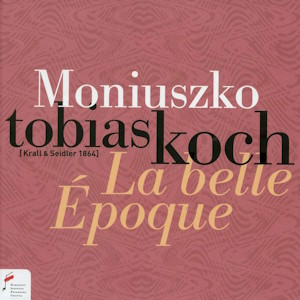
Stanisław Moniuszko (1819-1872)
La belle Époque
Tobias Koch (period piano)
Katarzyna Drogosz (2nd piano)
rec. 2020, Witold Lutosławski Concert Studio of Polish Radio
Fryderyk Chopin Institute NIFCCD107 [65]
Stanisław Moniuszko was born in Ubiel in what is now Belarus and studied in Warsaw, Minsk and Berlin. After his studies he lived in Vilnius where he was engaged as an organist and it is here that many of his piano work were written. In 1859 he moved to Warsaw where he taught at the Warsaw Musical Institute and became conductor at the Grand Theatre after the success of his opera Halka which had been performed there in 1858. In Poland Halka has remained in the repertoire and some of his other operas, Straszny dwór, the Haunted Manor amongst them, are occasionally still heard. It is with vocal music that Moniuszko is most associated and indeed I first heard his name through piano transcriptions of Halka and his songs by the likes of Carl Tausig and Henryk Melcer. He did however write some 180 works for piano and Tobias Koch presents a selection of these from his earliest works to his last piano piece. The piano used on this recording, a Krall and Seidler from c.1864, was more than likely played by Moniuszko himself; it was passed on to his daughter Joanna Jadwiga Zofia when she married in 1873 and then on through the family, finally residing at the Theatre Museum at the Teatr Wielki opera house.
Moniuszko’s piano works are mostly modest in scope, suitable for the amateur player and cover a wide range of genres. Most popular and numerous amongst these, not surprisingly considering the Polish folk elements that imbue much of his music, are Polonaises. Koch plays Polonaises taken from a set of six published in Vilnius and six polonaises by Prince Michał Ogiński to which Moniuszko made textural and harmonic changes. Unless I am very much mistaken the polonaises attributed to the Ogiński set in the list of contents are actually mostly from the earlier Vilnius set – the sixth, track 22, is marked correctly. These, and the polonaise in E flat major, all follow the same ternary format, outer sections enclosing a contrasting central section. Much of the lyricism of Chopin’s polonaises can be heard here though Moniuszko does not approach the epic scale of Chopin’s familiar tone-poems. The Citizen Polonaise for piano four hands is much the same though it opens with a grand introduction before the main theme enters, that theme being Miecznik’s Act 2 aria from the Haunted Manor, suitably adorned, and it is the most dramatic of the polonaises here. The earliest pieces are the five Bagatelles from 1843. Again there is a folk-dance element to these short pieces – no.10, a brief mazurka lasts just 24 seconds; no.8 is another mazurka and nos.1, 4 and the touching 9th are all waltzes. Perhaps most familiar amongst his piano works are the three waltzes published by Rudolf Friedlein in 1852. These are the most Chopin like of the works here; the chromaticism and sinuous lines are very reminiscent of early Chopin Waltzes. For me the E flat minor waltz is one of Moniuszko’s most beautiful works with its glorious melody and sense of melancholy. In parts it is as haunting as the Elegy, a work which is dark and brooding without being despairing and mostly inhabits the lower reaches of the keyboard. Two short songs without words are the delicate Souvenir from the album of Miss Maria Peszke, about whom the booklet is silent and the lullaby Days of Joy, Moniuszko’s last piano work. This could almost be a transcription of one of his many songs and indeed many of his piano works are arrangements of orchestral and vocal works. Whilst the last of the Vilnius polonaises was transcribed the other way, appearing later as Horatio’s Polonaise in Act 3 of his 1859 opera the Countess, the enchanting Aria with carillon is a transcription of part of Stefan’s impassioned aria from act 3 of the Haunted Manor.
Tobias Koch plays all with charm and grace and whilst I am not normally a fan of period pianos this one suits the recital well, especially in the contrasts of the aria with carillon. Presentation is first class, a hard back book style enclosing booklet notes in Polish and English about the music and a history of the piano as well as images including a sketch of Moniuszko at the piano that was drawn by his father around 1842 so too early to be the piano on this recording. Moniuszko’s piano works are never going to rival his vocal music in popularity and were never intended to but this is nonetheless a wonderful introduction to his more salon style.
Rob Challinor
Help us financially by purchasing from


Contents
Three Waltzes, E flat minor, E flat major, A (pub.1852)
Bagatelles Nos.1, 4, 8, 9, 10 (pub.1843)
Aria with Carillon (pub.1877)
Elegy in E flat major (1866)
Souvenir from the album of Miss Maria Peszke
Lullaby Days of Joy (1872)
Six Polonaises after Prince Michał Ogiński, Nos. 1,2,3,6 (pub.1858)
Six Polonaise, Nos. 1,2,3,5,6 (pub.1846)
Polonaise in E flat (pub.1860)


















